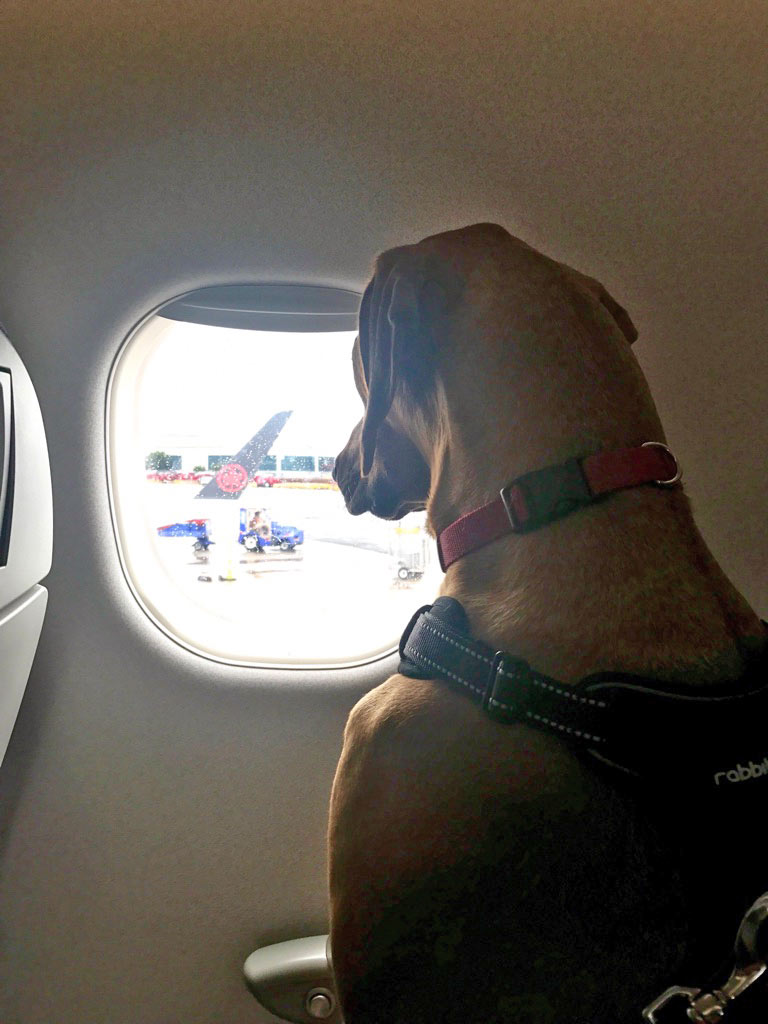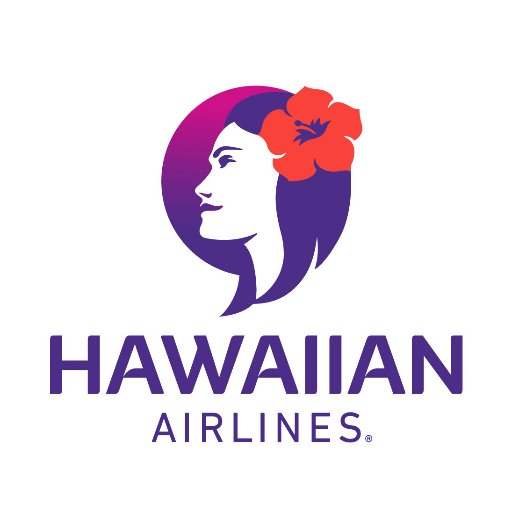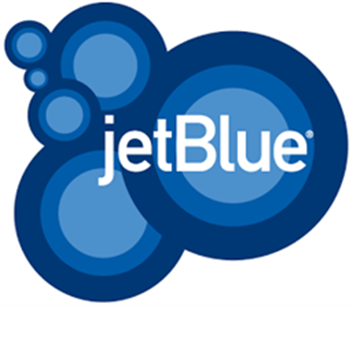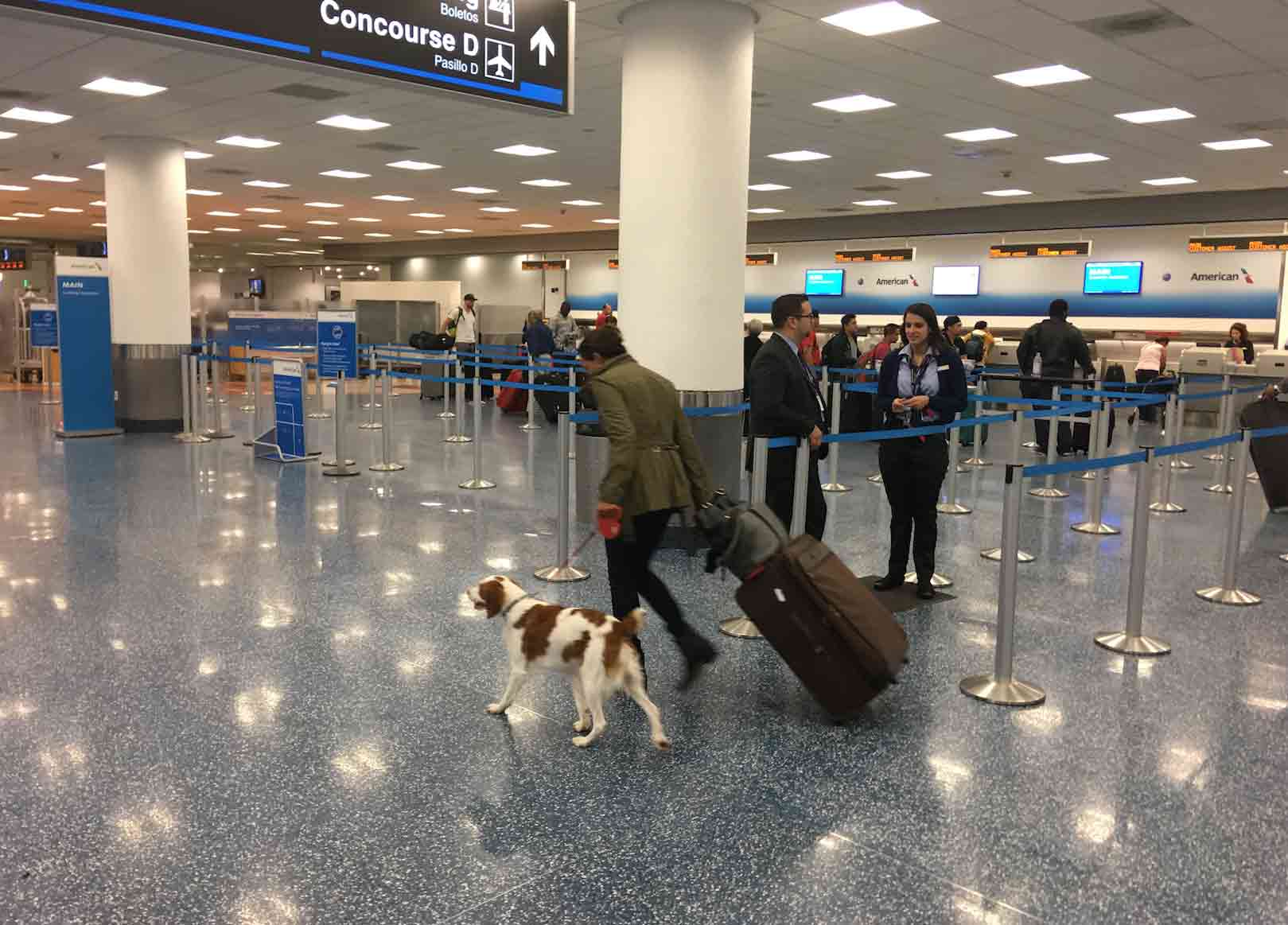Flying with Your Dog UPDATED!
People love traveling with their pets. The Department of Transportation says more than 185,000 animals were transported by airlines in 2022!
In this comprehensive post, Urban Dog will outline general guidelines for flying safely with dogs; discuss the new Department of Transportation rules about flying with service dogs and emotional support dogs; and then, outline each airlines’ policies regarding flying (in alphabetical order) including updated fees.
Click on the following links to jump to the information you need or the airline you want to learn more about. The information herein was current as of July 2023.
• Recommendations for Flying with Dogs
• Federal Rules for Service and Emotional Support Animals
• Alaska Airlines
• American Airlines
• Delta Air Lines
• Frontier Airlines
• Hawaiian Airlines
• JetBlue
• Southwest
• Spirit Airlines
• United Airlines
• Research Your Destination Requirements
• Pet Safety on Flights
• Concierge Services

Recommendations for Flying with Dogs
Here are Urban Dog’s “universal rules” regarding flying with your dog. These are our recommendations that we feel you should follow no matter what a particular airline’s policies are.
Health Certificates: Take your dog in for a check-up. Get paperwork from your vet certifying that your pet is healthy and is up-to-date on all of their shots. Even if your airline doesn’t have specific requirements about health paperwork, your destination may require certificates of health. It is worth it to be prepared for any eventuality.
PLEASE NOTE: Hawai’i, as the only rabies-free state in the United States, has very strict requirements about bringing animals into the state. Click here for the full set of rules.
Sedation: Do not sedate your dog for the duration of the flight. You can find any number of sources, including some airlines, saying they “don’t recommend it” or “you should avoid it.” Urban Dog’s veterinary experts all say “absolutely not!” One of Bodhi’s vets Dr. Dion Osborne and others say that flying with your dog under sedation, even if they are very healthy, could result in any number of serious, unforeseen outcomes.
Crates and Carriers: Get a USDA-approved shipping crate for flying in cargo and an airline-approved carrier for flying in the cabin. The requirements vary from airline to airline.
Food and Water: Feed your dog and give your dog water well in advance of flying. Dogs should fast for at least six hours before lifting off.
Pooping and Peeing: Walk your dog before flying, making sure your dog has one last pit stop as close to travel time as possible.
Identification: Properly label your dog and your dog’s carrier with names and contact info. Crates should have “Live Animal” plastered all over them. You should also carry a picture of your pet with you in case they somehow get away from you or gets loose.
Connecting Flights: Book direct flights. This avoids any time spent on the tarmac between flights and reduces the chances of your pet being mishandled by baggage personnel.
Communicating with Airline Staff: Make sure every airline employee you encounter knows you are flying with your dog checked in the cargo hold. In a worst-case scenario you will want airline staff to know that your pet needs to be removed from the cargo.
Age: Fly with dogs that are eight weeks old and weaned; most airlines have this requirement. Delta is the exception; they say that dogs need to be ten weeks old and weaned.
New Federal Rules Regarding Flying with Service and Emotional Support Animals
For years now people have taken advantage of vague rules regarding service animals and emotional support animals and have brought a wide variety of animals into the cabin free of charge (emotional support kangaroo!?!) That has now changed. In January 2021, as part of the Air Carrier Access Act, the Department of Transportation issued a new rule regarding flying with service and emotional support animal.
Airlines will now accept only service dogs (dogs only!) that are trained to do work or perform tasks for the benefit of a qualified individual with a disability. One of the best known examples of service dogs are guide dogs who assist blind or sight-impaired people.
I think it’s appropriate to list the new DOT rules here in full.
- This final ruling defines a service animal as a dog that is individually trained to do work or perform tasks for the benefit of a person with a disability;
- No longer considers an emotional support animal to be a service animal;
- Requires airlines to treat psychiatric service animals the same as other service animals;
- Allows airlines to require forms developed by DOT attesting to a service animal’s health, behavior and training, and if taking a long flight attesting that the service animal can either not relieve itself, or can relieve itself in a sanitary manner;
- Allows airlines to require individuals traveling with a service animal to provide the DOT service animal form(s) up to 48 hours in advance of the date of travel if the passenger’s reservation was made prior to that time;
- Prohibits airlines from requiring passengers with a disability who are traveling with a service animal to physically check-in at the airport instead of using the online check-in process;
- Allows airlines to require a person with a disability seeking to travel with a service animal to provide the DOT service animal form(s) at the passenger’s departure gate on the date of travel;
- Allows airlines to limit the number of service animals traveling with a single passenger with a disability to two service animals;
- Allows airlines to require a service animal to fit within its handler’s foot space on the aircraft;
- Allows airlines to require that service animals be harnessed, leashed, or tethered at all times in the airport and on the aircraft;
- Continues to allow airlines to refuse transportation to service animals that exhibit aggressive behavior and that pose a direct threat to the health or safety of others; and
- Continues to prohibit airlines from refusing to transport a service animal solely based on breed.
Psychiatric service dogs are still protected under the Air Carrier Access Act; but emotional support animals — which are certified by a mental health professional such as a psychiatrist, psychologist, or other licensed mental health care provider for a person with an emotional or mental disability — are not.
The bottom line is travelers can no longer slap a vest on their pet that says “emotional support animal” and bring it in to the cabin free of charge. Airlines now require proof that your dog is a certified service animal.
For more on service dogs and emotional support animals, read this article from the American Kennel Club.
And here’s a link to the DOT for more about the final ruling.
Airline Pet Policies
Here are some details about flying with your dog on each of the major carriers. They are listed in alphabetical order. You should definitely check with each airline’s website for details and to make sure none of the info I’ve included below has changed.

Alaska Airlines
www.alaskaair.com
1-800-252-7522
Dogs Can Fly in Cabin: Yes, subject to availability.
– You must be 18 years or older to travel with a pet in the cabin.
– When traveling with a pet, you may not occupy an emergency exit row or bulkhead row.
– Your pet counts towards your carry-on allotment. You can bring a pet carrier and a personal item or a pet carrier and a standard size carry-on bag.
– The First Class cabin can accommodate a total of three pet carriers per flight, and the Main Cabin can accommodate a total of eight pet carriers per flight.
– You may travel with a maximum of two pet carriers in the main cabin, only when you purchase a second ticket with an adjacent seat.
– Only dogs, cats, rabbits, and household birds are permitted in the Main Cabin.
– Dogs and cats must be at least eight weeks old and must have been fully weaned and accustomed to take solid food and have done so, without nursing, for a period of at least five days.
– The pet must stay in its carrier (including head and tail) with the door/flap secured at all times in the boarding area (during boarding and deplaning), Alaska Lounge, and while onboard the aircraft.
– The pet must be stowed under the seat, in its carrier during taxi, takeoff and landing.
– Up to two pets of the same species and similar size may travel in the same carrier, provided no body parts protrude from the carrier and the animals are not in distress.
– Animals with offensive odors or those that create a noise disturbance must travel in our climate-controlled baggage compartment.
– Additional requirements and documentation are needed for pets traveling to Hawaii or internationally.
Dogs Can Fly in Cargo Hold: Yes, subject to availability.
– Pet and carrier must weigh no more than 150 lbs, combined.
– You must travel on the same flight(s) to your pet’s destination. If you are not planning to travel, please visit alaskacargo.com for information about our Pet Connect™ service.
– Dogs and cats must be at least 8 weeks of age and weaned.
– Pets may not travel in the baggage compartment of an Airbus aircraft. More information on identifying our Airbus fleet is available later on this page.
– Brachycephalic dogs and cats are not accepted for travel in the baggage compartment.
– No more than 1 live dog or cat, 6 months of age or older, may be transported in the same carrier.
– No more than 1 live puppy, 8 weeks to 6 months of age, and weighing over 20 lbs, may be transported in the same carrier.
– No more than 2 live puppies or kittens, 8 weeks to 6 months of age, that are of comparable size, and weighing 20 lbs or less each, may be transported in the same carrier.
– Animals must be harmless, inoffensive (not destructive to itself or the carrier), and require no attention during transit.
– For travel to Hawaii or international travel; additional restrictions apply and additional documentation may be required.
– You must offer food and water to your pet no more than 4 hours before check-in.
– You will be asked to complete a Pet Check record to certify that you have done so.
– On the day of travel, check in no more than 2 hours prior departure, but at least 90 minutes before departure in Seattle or Guadalajara, or at least 1 hour prior to departure at all other airports. Visit the airport guide for recommended arrival times at your departure airport.
Cost: $100 per pet in cabin; $150 per pet traveling in the baggage compartment.
Health Certificate: A health certificate issued by a licensed veterinarian is required for each pet traveling in the baggage compartment
Click here to visit Alaska Airline’s Fur-st Class Care page. It has more info, including requirements about carriers and crates.

American Airlines
www.aa.com
1-800-433-7300
American Airlines has very specific, detailed rules and restrictions about traveling with pets to various parts of the world. Check their website for details. American allows travel with pets on most flights not longer than 12 hours, including the time it takes to clear customs at arrival cities. American has some first class little dog cabins.
Dogs Can Fly in Cabin: Yes, subject to availability.
– Pets must travel in an airline-approved carrier that fits under the seat in front of you.
– Pets must fit inside carrier; no body parts may protrude from carrier.
– Passenger can travel with one pet.
– Pet carrier counts as one of your two carry-ons.
Dogs Can Fly in Cargo Hold: Yes, subject to availability.
– Contact Reservations at least 48 hours prior to travel.
– Check in at the ticket counter with your official orders.
– Allow extra check-in time (at least 2 hours and no more than 4 hours before your flight.)
– Complete a checklist with an agent.
– Travel to certain destinations can be restricted due to temperature and weather considerations.
– Brachycephalic dogs and mixes are not allowed. See airline website for complete list of breeds.
– Allow extra time for check in, but no more than four hours before departure.
– USDA-approved crate required.
– Passengers are allowed to check two pets.
– Flights connecting to other American flights are only allowed through ten airports in the US. Check airline website for details.
– American also has specific requirements regarding food and water for checked pets; labeling of crates; and medicine. Please consult airline website for details.
– Your pet has been fed and offered water within 4 hours (with the specific time noted) before you deliver them to the airplane. Is securely and visibly attached to the outside of the kennel. Has your signature with the date and time you signed it.
– Dogs that have been sedated will not be accepted.
Cost: $125 each way for pets traveling in the cabin. For checked cargo: Active-duty Military and State Department personnel pay $200 ($150 for pets traveling to Brazil); for regular passengers, cargo checked costs vary with each destination.
Health Certificate: Required for cargo. Must be dated within ten days of initial travel and 60 days of return travel on same ticket. Ten days of your return on a separate ticket. Not required in cabin.
Visit the American website for all of the details regarding flying on that carrier, including requirements for carriers and crates.

Delta Air Lines
www.delta.com
1-800-221-1212
Delta Air Lines has very specific restrictions about traveling with pets to various parts of the world. Check their website for details. Delta allows travel with pets on most flights not longer than 12 hours, including the time it takes to clear customs at arrival cities. Delta ships pets through a service called Delta Cargo. This is different than flying on Delta’s regular commercial passenger flights.
Dogs Can Fly in Cabin: Yes, subject to availability.
– Pets must travel in an airline-approved carrier that fits under the seat in front of you.
– Pets must fit inside carrier; no body parts may protrude from carrier.
– Maximum carry-on carrier dimensions are determined by your flight as the space under seats vary by aircraft, check with Delta for details.
– Delta also has restrictions on what seat you can sit in. This varies by aircraft type. Check with website for details.
– Passenger may travel with one pet. Delta has some exceptions, especially where it concerns litters and puppies, to this rule. Check airline website for details.
– Pet carrier counts as one of your two carry-ons.
– Dogs must be ten weeks of age and weaned for domestic travel.
– Your pet must be 16 weeks old if traveling to the U.S. from another country and must be at least 15 weeks old when traveling to the European Union.
-Also check website for a list on destinations where carry on pets are not allowed.
Dogs Can Fly in Cargo: Yes, subject to availability. Please note that Delta ships pets through a service called Delta Cargo. This is different than flying on Delta’s regular commercial passenger flights.
– A separate booking from their flight itinerary is required. Additional fees and charges may apply.
– A pet shipped domestically via Delta Cargo cannot be booked until 14 days prior to departure
– Travel to certain destinations is restricted due to temperature and weather considerations.
– Delta does not guarantee to ship animals on the same flight or flight schedule as passenger.
– Pets must check in a Delta Cargo location at least three hours before departure and separate from regular passenger check in. Picking up the pet at the destination would occur at a Delta Cargo location as well.
– Travel during certain holiday periods is restricted.
– Brachycephalic are not allowed. See site for complete list of breeds.
– Dogs must be ten weeks of age and weaned for domestic travel. Check airline website for international flight requirements.
– Age of the animal being shipped: USDA regulations require animals be at least 8 weeks old (10 weeks old to carry in cabin) and fully weaned before traveling domestically, at least 16 weeks old before traveling to the U.S. from other countries and at least 15 weeks old for European travel.
– USDA-approved crate required.
Cost: $95 for carry on for domestic and Canada-bound flights; $200 for international carry on; $75 for Brazil-bound carry on. Contact Delta Cargo for shipping costs.
Health Certificate: Required for cargo. Must be dated within ten days of initial travel and 30 days of return travel. Not required in cabin.

Frontier Airlines
www.flyfrontier.com
1-801-401-9000
Dogs Can Fly in Cabin: Yes, on domestic flights and flights to Mexico and the Dominican Republic.
– Pets must travel in an airline-approved carrier that fits under the seat in front of you
– Pets must fit inside carrier; no body parts may protrude from carrier.
– Pet carrier counts as one of your two carry-ons.
– Domesticated dogs and cats must be minimum 8 weeks of age.
– You may not sit in row one or an exit row when traveling with a pet.
– For safety reasons, your pet must remain in the travel container at all times. If your pet is disruptive, it’s up to you to soothe it without taking it from the pet container.
– Your pet needs to be harmless, not disruptive, odorless, and require no attention during flight.
Dogs Can Fly in Cargo Hold: No.
Cost: A one way directional charge will apply each way. I’m guessing it has to do with weight and size of carry on bag — which suggests there is probably a weight restriction — but I could not easily find any guidance on Frontier’s website. When I tried to call to get info, I found out that you have to pay to speak to a real, live person. I could not get prices using their free robo-chat feature. I am dedicated to keeping Urban Dog current and full of information, but I was unwilling to pay to get this information. Other websites I looked at quote a price of $99 each way; contact Frontier directly to learn more.
Health Certificate: Not required for domestic travel; required for flights to Puerto Rico and international travel. Certificates must be dated anywhere from within five to 30 days of entry depending on the destination.
Check the airline website for details.

Hawaiian Airlines
www.hawaiianairlines.com
1-800-367-5320
Flying with your dog in Hawai’i has special travel considerations. Because it is the only rabies-free state is has a number of strict guidelines you need to follow. Please follow this link for details.
Dogs Can Fly in Cabin: Yes, permitted only on inter-island flights within Hawaii, and flights between the State of Hawaii and the US mainland (excluding flights to/from JFK, BOS, or AUS).
– Only dogs and cats are permitted for travel in the passenger cabin.
– Your pet must be in an approved carrier, not to exceed 16” long x 10” wide x 9.5” high.
– The pet and carrier combined may not exceed 25 lbs total.
– Carriers containing animals will be measured and weighed at check-in. Animals will be visually inspected to ensure size and breed compliance.
– You may book your pet in the passenger cabin at the same time that you make your own flight reservations (subject to applicable fees and space availability by calling Hawaiian Airlines reservations).
This is just the tip of the iceberg with Hawaiian. Click here for more about flying with Hawaiian with animals as carry on.
Dogs Can Fly in Cargo Hold: Yes, permitted only on inter-island flights within Hawaii, and flights between the State of Hawaii and the US Mainland (excluding flights to/from JFK, BOS, or AUS). Pet and crate cannot exceed 70 pounds. If they exceed 70 pounds they must be shipped through Hawaiian Airlines’ separate cargo service.
– Only dogs, cats and household birds are permitted to travel as checked baggage.
– Your pet must be in an approved kennel, not to exceed 36” long x 25” wide x 28” high.
– Kennels containing animals will be measured and weighed at check-in. Animals will be visually inspected to ensure size and breed compliance.
– The pet will be loaded in the baggage compartment of your passenger flight. Pets checked as baggage cannot travel unaccompanied.
– You may book your pet as checked baggage at the same time you make your own flight reservations (subject to applicable fees and space availability. You may call our Reservations Department at 1-800-367-5320 to make your arrangements).
For the full details click here for more about flying with Hawaiian with animals checked into cargo.
Cost: $35 each way within Hawai’i; $125 between Hawai’i and North America.
Health Certificate: For travel within the State of Hawaii, no animal health certificate is required. For travel between Hawaii and North America a health certificate dated within 14 days prior to arrival is required.
Check website for all the info regarding flying with Hawaiian.

JetBlue
www.JetBlue.com
1-800-538-2583
Dogs Can Fly in Cabin: Yes, subject to availability.
– Your pet and approved pet carrier count as one personal item and must fit under the seat in front of you.
– Your pet carrier cannot exceed 17″ L x 12.5″ W x 8.5″ H (43.18 cm L x 31.75 cm W x 21.59 cm H) and the combined weight of your pet and the carrier must not exceed 20 pounds).
– A maximum of two pets per traveler is allowed, each in their own carrier. In order to bring a second pet, a second seat and pet fee must be paid.
– Traveling on a Blue Basic fare? Carry-on bags are not permitted, but you may bring a personal item in addition to the pet carrier.
– Only one pet is allowed per carrier, and they must be able to turn around comfortably when it’s closed.
– All pets must remain inside the pet carrier while at the airport and on the plane.
Dogs Can Fly in Cargo Hold: No.
Cost: $125 each way.
Health Certificate: JetBlue asks you visit the Help Page to get the low down on health requirements.

Southwest
www.southwest.com
1-800-435-9792
Dogs Can Fly in Cabin: Yes, subject to availability.
– Pets must travel in an airline-approved carrier that fits under the seat in front of you.
– Pets must fit inside carrier; no body parts may protrude from carrier.
-Pets flying to Puerto Rico may have specific requirements. Pets are not allowed on flights from the mainland to Hawai’i. Inter-island travel is allowed.
– Passengers traveling with pets may not sit in an exit row seat or a seat with no under-seat stowage in front of them.
– Pet carrier counts as one of your two carry-ons.
– Pets must be at least 8 weeks old to travel.
Dogs Can Fly in Cargo Hold: No.
Cost: $95 each way. Inter-island travel in Hawai’i is $35 each way.
Health Certificate: Not required in cabin, but must be vaccinated.
Click here for complete information about flying with a dog on Southwest.

Spirit Airlines
www.spirit.com
1-855-728-3555
Dogs Can Fly in Cabin: Yes, subject to availability.
– Pets must travel in an airline-approved carrier that fits under the seat in front of you.
– A maximum of 2 pets per container is permitted, but only one container per guest is allowed.
– The combined weight of the pet and carrier may not exceed 40 pounds (18.14 kg.)
– Animals must be able to stand upright and move about comfortably in the container.
– Animals must remain in the carrier for the duration of the flight.
– The pet should be at least eight (8) weeks old and fully weaned.
– The animal must be harmless, inoffensive, odorless, and require no attention during the flight.
– An animal that becomes offensive or causes a disturbance prior to leaving the gate will be removed.
– Pet cannot be ill, violent, or in physical distress.
– Passengers may choose to sit anywhere they wish with the exception of the first row and emergency exit rows.
Dogs Can Fly in Cargo Hold: No.
Cost: $125 each way.
Health Certificate: Not required in cabin except for flights to the USVI. Proof of rabies vaccination is required for travel to Puerto Rico.
Check with Spirit for more.

United Airlines
www.united.com
1-800-864-8331
United Airlines has very specific restrictions about traveling with pets to various parts of the world. Check their website for details. United allows travel with pets on most flights not longer than 12 hours, including the time it takes to clear customs at arrival cities. You have to fill out an application online for your dog to fly in cargo. This is different than booking your flight through United’s regular commercial flights.
Dogs Can Fly in Cabin: Yes, subject to availability.
– Pets must travel in an airline-approved carrier that fits under the seat in front of you.
– Pets must fit inside carrier; no body parts may protrude from carrier.
– Pet carrier counts as one of your two carry-ons.
– Dogs must be eight weeks of age and weaned.
Dogs Can Fly in Cargo Hold: No. (United suspended its cargo service in 2020.)
Cost: $125 each way. There is an additional fee of $125 for each stopover of more than four hours within the US or more than 24 hours outside the US.
Health Certificate: Required for cargo. Must be dated within ten days of both outbound and inbound travel. Not required in cabin.
Research Your Destination
Be thorough when researching your destination!
Different states may have different requirements from what you expect. Sometimes cities and other municipalities may have more stringent rules than the states they are in. For example, Nome, Alaska requires proof of Parvovirus vaccine while the state itself does not.
Also, as noted above, travel to Hawai’i has special considerations because it is the only rabies-free state in the Union. Here’s a link to very thorough FAQ page on the Hawai’i Department of Agriculture’s website. It should answer any questions might have about bringing animals to the Aloha State.
Flying with your dog to international destinations comes with many, many more requirements than does domestic travel. Research your destination very thoroughly. Many countries require you to quarantine your pet upon arrival. That’s definitely something to consider when planning your travel. Also look into the rules regarding what a country can do if your flight is delayed while making a connection. If you are in a country too long, it may become subject to the rules of that country even if it’s not your final destination. You can get in touch with an American consulate in the country you are traveling to get the most up-to-date information. Covid has also changed the rules about flying Internationally with your pet. Here’s a link to a New York Times article about that.

Pet Safety on Flights
I checked with Urban Dog’s resident veterinary expert, Dr. Christina Moore, and she says, given a choice, she wouldn’t put her dogs in the cargo hold. She says it can be very stressful. The Humane Society also recommends against checking your pet in the cargo hold.
However, you may not have a choice. I did a little research and found some relevant statistics in the Department of Transportation’s Air Travel Consumer Report for 2022: carriers reported seven animal deaths; injuries to one other animal; and one lost animal. That’s a total of nine incidents, which is down from the 19 incident reports filed for pre-pandemic calendar year 2019 (the last year there was a comprehensive report.)
In 2022 188,223 animals were transported by airlines, for a rate of 0.48 incidents per 10,000 animals transported. In pre-pandemic 2019, 404,556 animals were transported, for a rate of 0.47 incidents per 10,000 animals transported.
Here’s link to a Long Haul Trekkers blog post about traveling with dogs in cargo. The folks there specialize in traveling with dogs. It repeats a lot of what I wrote about above in the Recommendations section, but I thought I’d include this just so you can get a slightly different perspective from mine.
Pet Travel Concierge Services and Charter Flights
If you have the money, you might consider special concierge services or charter flights when flying with your dog. Friends of ours, who moved from New York City to Sao Paolo in Brazil, used a concierge service and were very happy with the result. The service facilitated and monitored the dog’s travel. Most important, they responded to requests from the dog’s owner in Brazil when he started to think that the dog had been in his crate too long before they could claim him. There are also plenty of private charter groups that allow flying with your dog the cabin. There are too many charter groups and concierge services to list here, but a good place to start is IPATA, the International Pet and Animal Transportation Association.
And here’s an article from the Robb Report about flying on private charters.
For more information on transportation issues, click here for advice on how to navigate travel in New York City in Urban Dog’s post: Dog Friendly Transportation in New York City.







2 comments